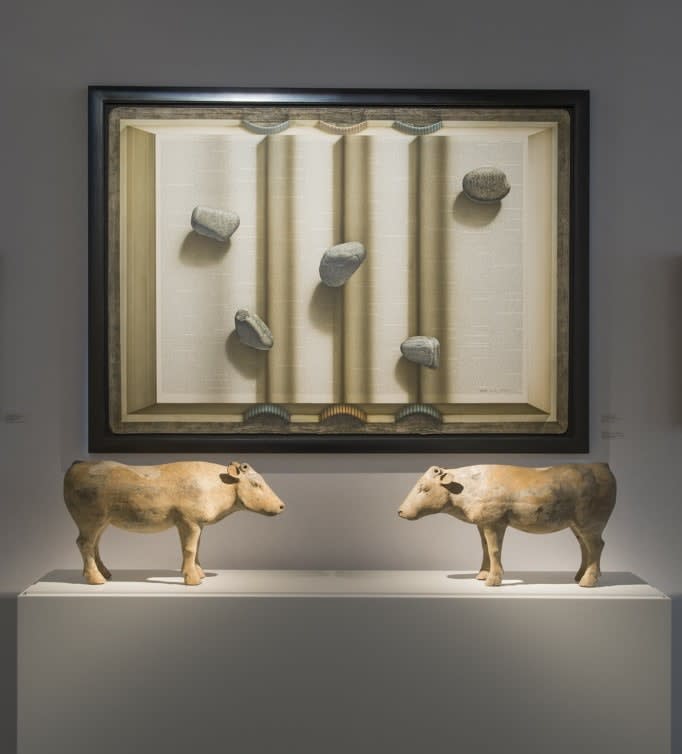Œuvres
Young-Hoon Ko South Korean, 1952
Plus d'images
Ko Young-Hoon est né en 1952 à l'île de Jeju, en Corée.
"C’est à l’université que mon attachement aux pierres dans mon travail était à son maximum. Une atmosphère informelle m'a rappelé mon rejet de la nature, mais aussi mon adoration pour elle. À cette époque, mes sujets préférés étaient les choses pures et naturelles, comme les pierres, les arbres, l’eau, le ciel. J'ai choisi les pierres comme matériau, car je pensais qu'elles représentaient l'aspect le plus primordial de la nature. Les pierres pour moi à l'époque représentaient un grand univers idéalisé et un monde transcendant, séparé de la réalité. Mais au fil du temps, je leur ai donné un sens plus conceptualisé, en les considérant d'un point de vue logique, et ils sont devenus à la fois un élément matériel et un élément descriptif. L'élément matériel suscite l'intérêt pour un objet et représente une coexistence avec la nature et la culture, c'est-à-dire que la pierre représente une culture primitive et la généralise comme réalité et idéal."
Ma vie change le sens des pierres et les transforme de la réalité en un symbole. C'est une contradiction humaine qui découle de la différence entre le naturel et l'intelligence. Mais cette contradiction particulière signifie que deux aspects extrêmes coexistent et sont même guidés vers une forme d'harmonie. C'est comme si une image avait été créée par deux yeux focalisés. Je ne pense pas que mes critères de sélection soient basés sur la logique ou sur une théorie qui ne change que dans le temps et dépend de mon humeur. Pour commencer, j'ai choisi des pierres droites, légèrement pointues, car je les ai associées à la souffrance de ma vie et à ma conscience critique. Mais au fil du temps, j'ai commencé à préférer les pierres courbes, rondes, roulantes et moussues. Mes critères sont passés d'extrême à modération. En tout cas, en parlant du choix de la pierre, ce n'est pas vraiment moi qui les choisis. Ce sont les deux pierres et je me choisis. Les pierres et moi avons du bon sens. La modification de la surface de mes peintures est rendue nécessaire par les exigences de ma vie, ainsi que par celles des pierres.
Lorsque j'ai peint les pierres pour la première fois, leur surface a été peinte en blanc pour compléter les pierres considérées comme un sujet transcendant idéal. Mais quand j’ai eu besoin d’une forte expression de la réalité de la vie, j’ai peint des journaux, une page de livre, et en particulier une relation entre eux et les pierres sur une surface. Autrement dit, je me suis intéressé aux problèmes liés aux pierres en tant que symboles et au message en lettres imprimées, à une représentation réelle de la spatialité incluant une relation mécanique créée par la gravité ou l’apesanteur, sur une correspondance dépendant de la position des pierres....
(...) Je suis comme un spectateur qui tire une image sublime de la pierre, une image méditative du zen, et la soutient contre un livre imprimé en tant que symbole de l'intelligence. Mon travail avec les pierres crée une tension harmonieuse entre des extrêmes paradoxaux. Mais mon intention implique un changement dépendant du cours de ma vie, et pour trouver un nouveau sens, je me laisse guider par un nouveau courant ".
Ko Young-Hoon, Les Pierres et moi
Provenance
Galerie Alain Blondel, Paris
Collection privée, achetée en 1993
Catalogues
Ko Young-Hoon, édité par Gana Art Gallery, Séoul 1992, reproduit p.67
Ko Young-Hoon, peintures, Editions Ramsay, Paris 1993, reproduit p.31
Join our mailing list
* denotes required fields
We will process the personal data you have supplied in accordance with our privacy policy (available on request). You can unsubscribe or change your preferences at any time by clicking the link in our emails.





